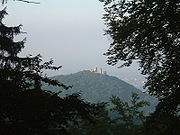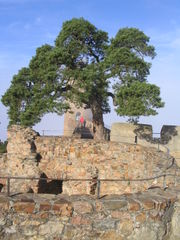
Auerbach Castle
Encyclopedia



Auerbach Castle is one of several dramatic fortresses along the Bergstrasse in southern Hesse
Hesse
Hesse or Hessia is both a cultural region of Germany and the name of an individual German state.* The cultural region of Hesse includes both the State of Hesse and the area known as Rhenish Hesse in the neighbouring Rhineland-Palatinate state...
, Germany
Germany
Germany , officially the Federal Republic of Germany , is a federal parliamentary republic in Europe. The country consists of 16 states while the capital and largest city is Berlin. Germany covers an area of 357,021 km2 and has a largely temperate seasonal climate...
.
The castle was originally built by King Charlemagne, Emperor of the Holy Roman Empire, and then re-built by Count Diether IV of the Katzenelnbogen
Katzenelnbogen
Katzenelnbogen is the name of a castle and small city in the district of Rhein-Lahn-Kreis in Rhineland-Palatinate, Germany. Katzenelnbogen is the seat of the Verbandsgemeinde Katzenelnbogen.-History:...
dynasty in the second quarter of the 13th century and stands prominently on a hill known as Urberg, an arm of Melibokus
Melibokus
The Melibokus is at 517 metres , the highest mountain in the Bergstraße region of southern Hesse, central Germany. The mountain overlooks the Rhine valley on the western fringe of the Odenwald region and is a local landmark, clearly visible for many miles...
mountain, above the town of Bensheim
Bensheim
Bensheim is a town in the Bergstraße district in southern Hesse, Germany. Bensheim lies on the Bergstraße and at the edge of the Odenwald mountains while at the same time having an open view over the Rhine plain...
-Auerbach.
History
Around 784 A.D., the town of Auerbach was mentioned for the first time in the Lorsch codexLorsch codex
The Lorsch Codex is an important historical document created between about 1175 to 1195 AD in the Monastery of Saint Nazarius in Lorsch, Germany. It consists of 460 pages in large format containing more than 3800 entries...
"Laureshamensis" as "Urbach".
Through the marriage of Hildegard von Henneberg
House of Henneberg
-Origins:The distant origins of this family are speculative yet seem to originate in the Rhine Valley, east of modern-day France. Charibert, a nobleman in Neustria is the earliest recorded ancestor of the family, dating before 636. Five generations pass between Charibert and the next descendant...
, areas of the Bergstraße passed to Henry II of Katzenelnbogen in 1135, who was ennobled as an earl in the year 1138 by King Konrad III. Auerbach now belonged to the County of Katzenelnbogen
County of Katzenelnbogen
The County of Katzenelnbogen was an immediate state of the Holy Roman Empire. It existed between 1095 and 1479, when it was inherited by the Landgraves of Hesse.The estate comprised two separate territories...
. County Katzenelnbogen was sub-divided into the Lower County, located around St. Goar on the Rhine, and the Upper County, located in what is now Southern Hesse, South of the Main.
There was clearly a need to establish a stronghold for securing the possessions of the Southern Katzenelnbogen dynasty, including the duties (tolls) collected at the town of Zwingenberg
Zwingenberg
Zwingenberg lies in the Bergstraße district in southern Hesse, Germany, south of Frankfurt and Darmstadt, and with the granting of town rights coming in 1274 it is the oldest town on the Hessian Bergstraße.- Location :...
from travellers using the well-known North-South trading route along the Roman 'mountain road' ('Strada Montana' or 'Bergstrasse' in German).
Auerbach Castle was built to address this need, on the strategically important Auerberg (Urberg) hill. It is likely that construction of the current castle began around 1222 by order of earl Diether IV von Katzenelnbogen, at the site of the original castle.
The earliest mention of a castle on Urberg in the historical record appears in 1247 and the first document of the castle itself dates from 1257.
In 1479 the County Katzenelnbogen, including Auerbach Castle, became the possession of the Landgraviate of Hesse
Landgraviate of Hesse
The Landgraviate of Hesse was a Landgraviate of the Holy Roman Empire. It existed as a unity from 1264 to 1567, when it was divided between the sons of Philip I, Landgrave of Hesse.-History:...
.
The castle lost much of its strategic importance during the 16th Century until, by the time of the Thirty Years War, it was no longer in military use.
In 1674 during the Franco-Dutch War
Franco-Dutch War
The Franco-Dutch War, often called simply the Dutch War was a war fought by France, Sweden, the Bishopric of Münster, the Archbishopric of Cologne and England against the United Netherlands, which were later joined by the Austrian Habsburg lands, Brandenburg and Spain to form a quadruple alliance...
(1672–1679) the castle was conquered and set on fire by an army under French Marshal Turenne
Henri de la Tour d'Auvergne, Vicomte de Turenne
Henri de la Tour d'Auvergne, Vicomte de Turenne,often called simply Turenne was the most illustrious member of the La Tour d'Auvergne family. He achieved military fame and became a Marshal of France...
, killing the local people who had sought protection within the ruin's walls. The abandoned castle became a ruin over the following years.
In 1820 the North tower of the castle collapsed, after which the Landgraviate of Hesse decided to secure and partially rebuild the ruins.
In 1888 an inn was built in the former Bailey
Bailey
-Fictional Characters:* Beetle Bailey, a comic strip created by Mort Walker* Bailey Pickett, a character on The Suite Life on Deck* Miranda Bailey, a character Grey's Anatomy...
, remaining open all year round.
In the 1950s, the South tower became inaccessible, due to the deterioration of its wooden staircase.
In 1989 building began on a new terraced restaurant, which opened in 1990, further increasing the attractiveness of the castle ruins for visitors.
In 2007, the stairway in the South tower was renewed and reopened to the public.
Viniculture
In 1258 a vineyard called the Grafenweinberg was recorded here, in 1318 one called the Reubere. There is still excellent viticultureViticulture
Viticulture is the science, production and study of grapes which deals with the series of events that occur in the vineyard. When the grapes are used for winemaking, it is also known as viniculture...
at the site today.
Design
The triangular shape of the castle KeepKeep
A keep is a type of fortified tower built within castles during the Middle Ages by European nobility. Scholars have debated the scope of the word keep, but usually consider it to refer to large towers in castles that were fortified residences, used as a refuge of last resort should the rest of the...
survives today. Between the wall from the North to the South tower and the inner courtyard were the kitchens, living quarters, stables and smithy. The original entrance, protected by a Donjon, was in the wall between the North and former East tower. Between the wall from the East to the South tower and inner courtyard were the grand hall, cellars, and the castle chapel.
In the eastern corner of the inner courtyard lies the original well, itself hewn vertically through 62 metres of bedrock.
The castle Keep is surrounded by a ring wall which encloses the Bailey
Motte-and-bailey
A motte-and-bailey is a form of castle, with a wooden or stone keep situated on a raised earthwork called a motte, accompanied by an enclosed courtyard, or bailey, surrounded by a protective ditch and palisade...
. A further forecourt is enclosed by another ring wall. At the south-side of this ring wall was the entrance to the estate.
On 18 October 1356 a powerful earthquake shook the Rhine rift. The Donjon collapsed, and crashed onto the eastern and southeastern buildings.
From around 1370, large scale rebuilding and expansion of the castle took place.
The donjon was demolished, the entrance to the keep relocated and the northern shield wall
Shield wall (fortification)
A shield wall refers to the highest and strongest wall of a castle where it is clearly distinguished from the other curtain walls of a castle. The shield wall serves to protect the side from which the main attack is expected...
was closed and raised. The entrance to the castle is now in the southwestern corner, where it is protected by the South-tower and an inner Bailey.
A four metre thick Bastion
Bastion
A bastion, or a bulwark, is a structure projecting outward from the main enclosure of a fortification, situated in both corners of a straight wall , facilitating active defence against assaulting troops...
was built in place of the East tower. This Bastion, the first of its kind in Germany, was designed to protect the castle from cannon bombardment from the North-East. It is possible that the North and South towers were raised at this time.
These additional fortifications, ordered by the Counts of the Katzenelnbogen, gave rise to the name "Feste Urberg" (Urberg Fort) and made Auerbach one of the most secure and modern castles of the world at that time.
Miscellaneous
Dinner theaterDinner theater
Dinner theater is a form of entertainment that combines a restaurant meal with a staged play or musical. Sometimes the play is incidental entertainment, secondary to the meal, in the style of a sophisticated night club, or the play may be a major production with dinner less important, or in some...
and Knight's Tournaments with medieval games are regular features at the castle nowadays. Sightseeing at the castle is free. Since the spring of 2007 both North and South towers are accessible to the public, following extensive restoration.

